
By P.J. Norwood and Sean Gray
Today, new debates are occurring around firehouse kitchen tables and training rooms across the fire service. These debates are positive discussions that are driving the fire service to where we should be operating. We, the American fire service, are behind in some aspects of our tactics and understanding of fire behavior. For too long we have relied on technology and haven’t paid attention to the changing fire environment and, therefore, have not changed our tactics.
Before you get frustrated, understand that not everything we do or know is wrong and needs to be changed. We are good, very good at what we do. We, as a whole, save countless lives and protect property every day. The fire service positively impacts our communities every day. However, that does not mean there is no room for improvement.
Some of the tactics we are still deploying were written in the 1950s for an enemy that is similar to but not the same as it is today. In fire academies, we are training to fight an enemy that is not the same enemy we see on the fireground.
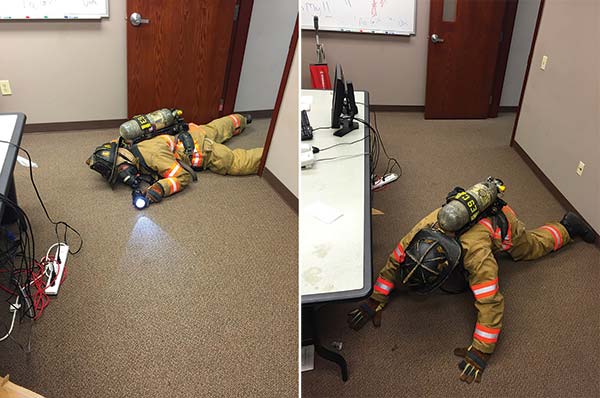 |
| (1) All firefighters should have a good hand light that enables them to see across a room during a search. (Photos by Chris Baines.) (2) Walking the walls allows the firefighter to get his hands out into the egress areas to feel and reach for victims. |
Search Modifications Needed
National Fire Protection Association (NFPA) 1403, Standard on Live Fire Training Evolutions, 2012 edition, dictates best practices for conducting live fire training. Although this standard is necessary, it does not allow us to train our members to fight the fires we are seeing today. We are not suggesting that we not use NFPA 1403. We are hopeful that in the future we can find a way to train firefighters in a more realistic setting by using materials that best resemble those on today’s firegrounds. When we train our members in Class A burn buildings using hay/straw and pallets, we are training to fight a fuel-limited fire. On today’s fireground, we are seeing very different ventilation-limited fires. Tactics and the results of our tactics on a ventilation-limited fire are different from those used in fuel-limited fires. We are giving our firefighters a false sense of security when we fight only fuel-limited fires during training.
Search techniques are among the tactics that must be adjusted. For example, the oriented search is one of the safest and most efficient ways to search. But if you think about the recent fire behavior and flow path information that has been released, having an officer staying oriented in the doorway is not the best idea. Is it not safer to go into a room, close the door, and search the room with an oriented officer as the door control firefighter? This firefighter/officer can now evaluate conditions as the search crew returns back to the open hallway and enters the flow path. This will slow the overall search task. Although it’s safer for firefighters, it’s not better for civilians. Smoke is the enemy. Don’t most victims die from smoke inhalation instead of from thermal injuries?
So, what’s the solution? Be aware that flow paths can contribute to rapidly changing fire conditions that kill firefighters and civilians. Basic search skills of experienced firefighters are essential. It’s time to get away from the “crawling conga line,” right/left hand search patterns taught in recruit school and use our knowledge, skills, and abilities to search smarter and faster.
 |
| (3) The thermal imaging camera is a valuable tool for search and firefighter safety. |
Looking under the smoke with a good light, it’s possible to see across a fairly large room in smoky conditions to locate a victim.
When walking along the walls, how about using your feet against the wall and getting your body and arms out into the room and rapidly moving laterally through the room?
Controlling the doors is the key to success when searching in today’s fires, but it depends on the fire’s location. For the sake of this article, let’s say that you are searching a residential hallway with bedrooms on each side and the fire is in a distant bedroom at the end of the hall. The best option is to start your search at the doorway or place of entry (don’t forget to check behind the door) and then proceed immediately down the hall toward the fire room. The search team should first attempt to control the fire room door to isolate the fire and interrupt its flow path. Then, the search team should search the bedroom closest to the fire room, where occupants are most endangered, and work back toward the room farthest from the fire.
Think of the hallway as the most dangerous place for firefighters. It’s directly in the flow path between the fire and the door through which we typically enter the structure. In the past, the hallway was where we would take refuge. According to the recent Underwriters Laboratories Firefighter Safety Research Institute (UL-FSRI) studies, hallway temperatures rapidly increase when you make ventilation openings (i.e., open the front door).
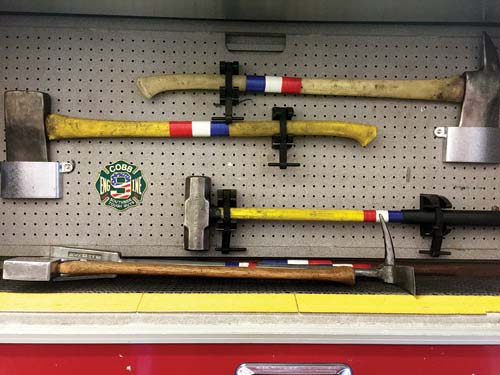 |
| (4) Firefighters across the country carry a variety of tools. However, the same rule applies: All firefighters show up with tools in their hands. |
By searching rooms individually and closing doors, you are limiting fire spread and making the environment safer for the search crew and the victims for whom you’re searching. Search crew leaders can remain oriented in the hallway with a thermal imaging camera (TIC) monitoring conditions. The search crew leader has to be aware of hallway conditions and control the fire room door. Use a TIC to scan the rooms quickly and then have the firefighter search the area that couldn’t be seen with the TIC. It takes about 15 seconds to search a 12- × 12-foot room.
Once you enter the room, close the door and begin the search. If the room is isolated from the fire, it is safe to ventilate the bedroom window. This will cause the smoke to lift, increasing visibility and survivability for any trapped victims. However, if the door cannot be controlled, do not take the windows! Taking windows without door control will put you directly in the flow path you create.
Numbering the walls (wall #1 is the wall parallel to the hallway; proceed to the left/clockwise, and so on) is beneficial to staying oriented while searching and keeping all crew members on the same page by having a standardized system. For example, the TIC/oriented person can tell the search firefighter to proceed to the 2/3 corner because it couldn’t be seen. The variation of the diagrams (Figures 1-3) shows the importance of numbering walls to create a system for the crew to follow. You will have to train as a crew and decide how to handle situations if there are two entry points or if another room (Figure 2) is encountered.

Searching with Tools
Every firefighter who enters the fireground should have tools with them. Many of us have been taught two hands, two tools. Which tools you carry will depend on a variety of variables. Keep in mind the tools necessary for forced entry and forced exit and that many variables, including changing fireground conditions, always exist. Always consider the environment and building variables when selecting your tools. When searching smaller residential bedrooms, search without tools. Use the walking-the-walls technique (photos 2, 3) to reach out with your hands to feel for victims. We have a few tips for several of the more popular tools used most commonly across the United States.
Halligan. The halligan is a very versatile tool that will not only enhance your search but also can be used for many other tasks. It can be used for forcible entry, wall breaching, opening walls, and bailouts, for example. During search, many firefighters hold the adz and pike end of the tool, sweeping and probing ahead. However, if you turn it around and hold the fork side and sweep the tool over a hole, it may alert you to the presence of a hole as the adz or the pike fork drops down. If the tool were flat, it may just slide over the top of the hole.
 |
| (5) You can use the pickhead ax for almost any task you can do with an ax or a halligan. |
Ax. The ax is another versatile tool that has many uses on the fireground. During search, it can be used for forcible entry, wall breaching, opening walls, and bailouts, for example. Many feel the pickhead ax does not have a place during search. However, if we look at firefighters across the country, there are more options and variations with different tools. Almost any task that can be completed with an ax or a halligan can be completed with the pickhead ax (photo 5). It can also be used for forcible entry for wood-frame residential doors. Photos 6-7 show a firefighter carrying a pickhead ax in a scabbard. Having the blade and pick encapsulated and your hands free to carry other equipment makes this arrangement appealing. Like any other tool or harness, it will take some time to get accustomed to the scabbard. When working in a zero visibility environment, it is comforting not to have to physically carry a tool and, more importantly, have the reassurance that the ax is on your hip if you need it.
New York hook (pike pole). Pike poles vary in length and can be cumbersome for search. However, every tool has its place and can be used successfully. The hook can be used to open walls and ceilings to check for extension, especially to check for concealed fire above right inside the entry door. It allows you to cover a larger area during search. If you place the tool against the wall, depending on the hook’s length, you can search a 10-foot path while still being oriented to the wall.
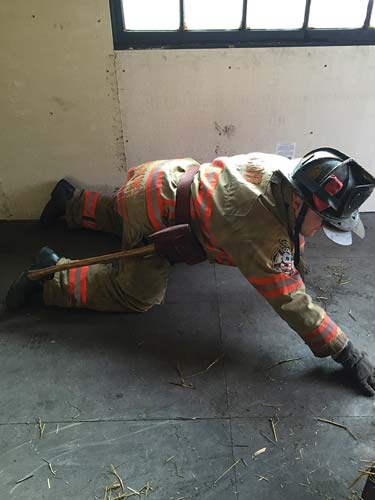 |
| (6) A pickhead ax is being used for search. |
Pressurized water fire extinguisher (can). While not normally considered a search tool, the 21/2-gallon water extinguisher is a good tool to accompany an aggressive search team. This technique can be cumbersome, but it is essential if searching in the flow path. The 21/2 gallons of water could be enough to get you close enough to the fire room to close its door and could be enough to delay flashover and control a fire while the search is conducted nearby.
As outlined above, get as close to the fire room as possible, control the fire room door, and then search backing away toward your egress. This will protect the search team by keeping the fire in check and preventing it from extending into the hallway. Although it may be cumbersome to crawl and search with a can, the can has its place with a search crew. Companies should add a carrying strap and practice with the can during training.
We have had great success training, practicing, teaching, and applying these techniques. The results have made crews more successful in their searches. It gets everyone on the same page, and it’s a lot better than the rookie school conga line.
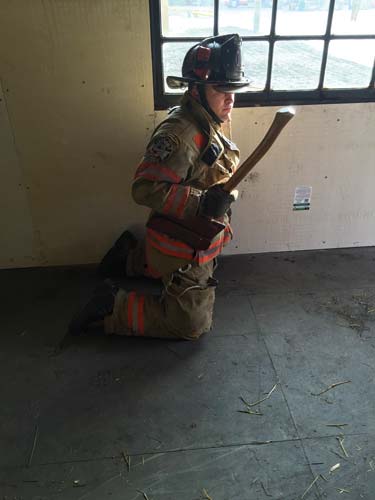 |
| (7) The scabbard allows the firefighter to carry a tool hands-free. |
Be Aware of the Flow Path
The significance of the flow path is possibly the most important consideration on today’s fireground. The front door is the entrance point for most teams. View it as a ventilation opening instead of as an entry/exit point. Ventilation openings increase the fire’s energy. The clock is ticking. If interior conditions rapidly deteriorate, find the nearest room that’s not on fire, and close the door. We’ve been taught to map out windows and exits while searching. Sheltering in place can be faster than trying to exit when things go wrong. Close the door, call a Mayday, and start thinking about your options. If you speak with firefighters who have been caught in a flashover, you’ll probably find that they did not have the time to exit the structure. Smart, proactive firefighters have constant awareness of rooms in which they can shelter in place.
Get inside and search efficiently and rapidly with the techniques described in this article. You may save your life, the lives of your crew, and those of civilians in need of rescue. Firefighter safety is of utmost importance, but we must not forget about the civilians we were sworn to save and protect.
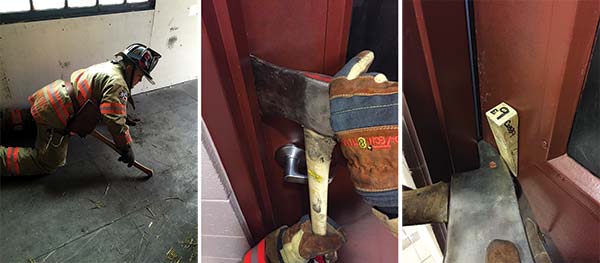 |
| (8-10) When selecting tools, always consider forcible entry tools for use in a search. |
Start learning as much as you can about fire dynamics and fire safety research. Incorporate the Firefighter Safety Research information in your fireground tactics to operate more efficiently and safely at your next fire.
P.J. NORWOOD is a deputy chief training officer for the East Haven (CT) Fire Department and has served four years with the Connecticut Army National Guard. He has authored Dispatch, Handling the Mayday (Fire Engineering, 2012), co-authored Tactical Perspectives of Ventilation and Mayday DVDs (2011, 2012), and was a key contributor to the Tactical Perspectives DVD series. Norwood is an FDIC instructor, a Fire Engineering contributor, a Fire Engineering University faculty member, co-creator of Fire Engineering‘s weekly video blogs “The Job,” and hosts a Fire Engineering Blog Talk Radio show. He serves on the UL Technical Panel for the Study of Residential Attic Fire Mitigation Tactics and Exterior Fire Spread Hazards on Fire Fighter Safety. He has lectured across the United States and overseas. He is certified to the instructor II, officer III, and paramedic levels.
SEAN GRAY started his fire service career in Southern California in 1993 and is a lieutenant with Cobb County (GA) Fire and Emergency Services. He has a bachelor’s degree in fire safety engineering from the University of Cincinnati and has many certifications in firefighting, technical rescue, hazmat, and emergency medical services. He is a member of the Georgia Search and Rescue Team Metro Atlanta Task Force. He is an FDIC instructor and has been published in Fire Engineering. He serves on the UL Technical Panel for the Study of Residential Attic Fire Mitigation Tactics and Exterior Fire Spread Hazards on Fire Fighter Safety. Gray is an UL Firefighter Safety Research Institute advisory board member and presents nationally on UL-FSRI research topics.
The Job: Flow Path and Door Control – Fire Engineering
A Typical Example of Smoke Curtain Use
The Fire Attack-Ventilation Connection: Street Considerations
Ventilation Limited Fire: Keeping it Rich and Other Tactics Based Off Science

